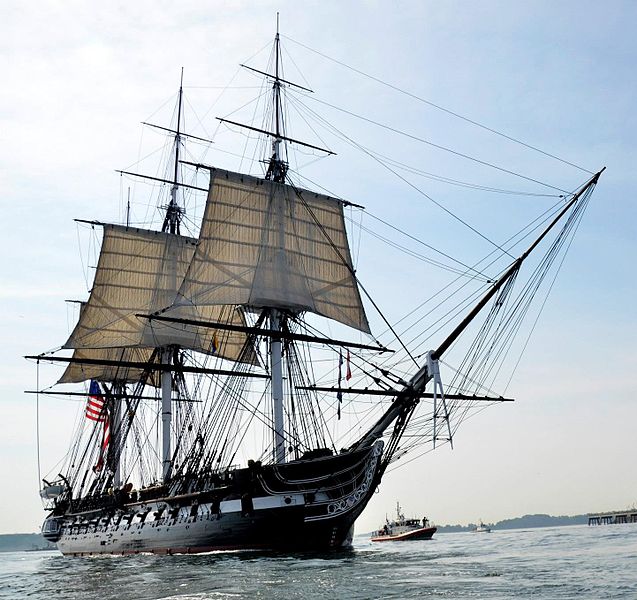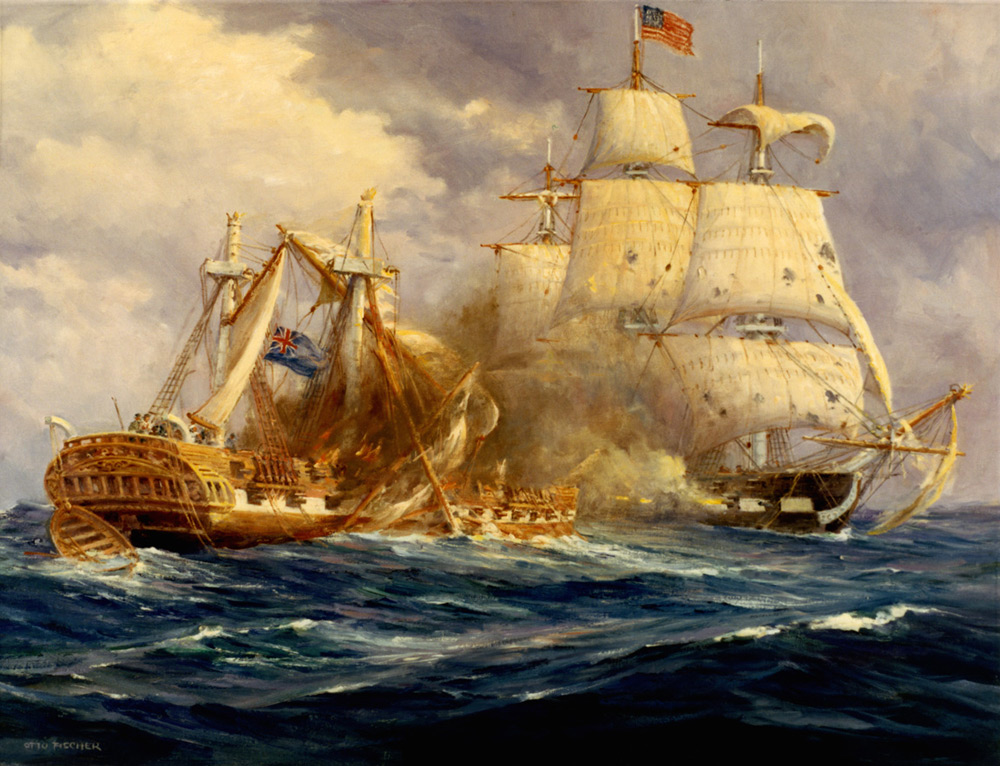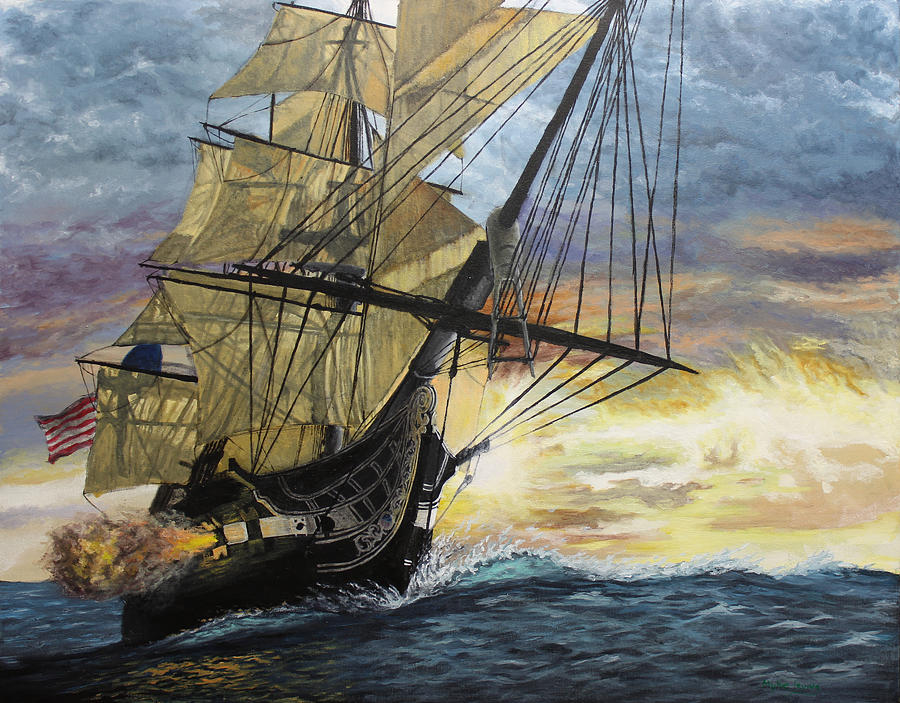When the United States won independence from Britain in 1783, the young nation soon learned that freedom was not without disadvantages. America had just lost her protector at sea.
British and French vessels harassed American merchant shipping, kidnapping American sailors and forcing them to serve in their own navies, a practice known as impressment.

Barbary pirates were a problem for Mediterranean shipping, and throughout parts of the Atlantic. Predominantly North African Muslims with the occasional outcast European, the Barbary pirates operated with the blessing of the Ottoman Empire, the Barbary Coast states of Algiers, Tunis & Tripoli, and the independent Sultanate of Morocco.
The Barbary Corsairs had long since stripped the shorelines of Spain and Italy in search of loot and Christian slaves. Many villages would not be re-inhabited until the 19th century.
Between the 16th and 18th centuries, thousands of ships were captured and held for ransom. Somewhere between 800,000 and 1.25 million Europeans disappeared into the Arab slave markets of North Africa and the Middle East.
Barbary pirates began to harass American shipping as early as 1785. They captured 11 American vessels in 1793 alone, holding both ships and crew, for ransom.
Congress passed the Naval Act of 1794, appropriating funds to build a fleet of 6 three-masted, heavy frigates for the United States Navy. The act included a clause halting construction, in the event of a peace treaty with Algiers. No such treaty was ever concluded.
Launched this day in 1797 and named by George Washington himself, USS Constitution was one of those six. Her hull was made of the wood from 2,000 Georgia live oak trees, and built in the Edmund Hartt shipyard of Boston, Massachusetts.
 Constitution’s first duties involved the “quasi-war” with France, but this was not the France which helped us win our independence. France had been swallowed up in a revolution of its own by this time. Leftists calling themselves “Jacobins” had long since sent their Bourbon King and his Queen Consort to the guillotine. Marie-Joseph Paul Yves Roch Gilbert du Motier, Marquis de Lafayette and Hero of the American Revolution, languished in an Austrian prison.
Constitution’s first duties involved the “quasi-war” with France, but this was not the France which helped us win our independence. France had been swallowed up in a revolution of its own by this time. Leftists calling themselves “Jacobins” had long since sent their Bourbon King and his Queen Consort to the guillotine. Marie-Joseph Paul Yves Roch Gilbert du Motier, Marquis de Lafayette and Hero of the American Revolution, languished in an Austrian prison.
The French Monarchy would one day be restored, but not before a certain Corsican artillerist would rise to the rank of Emperor to meet his Waterloo, fighting (and winning) more battles than Julius Caesar, Frederick the Great, Alexander the Great, and Hannibal, combined. But I digress.
The Barbary pirates were paid “tribute” during this time to keep them quiet, but that ended in 1800. Yusuf Karamanli, Pasha of Tripoli, demanded $225,000 from the incoming Jefferson administration. Jefferson refused, and Constitution joined in the Barbary Wars in 1803, a conflict memorialized in a line from the Marine Corps Hymn “From the Halls of Montezuma to the Shores of Tripoli.”

In the early months of the War of 1812, Constitution faced off with the 38-gun HMS Guerriere, about 400 miles off the coast of Halifax. Watching Guerriere’s shots bounce off Constitution’s 21-inch thick oak hull, one American sailor exclaimed “Huzzah! her sides are made of iron!” In twenty minutes, Guerriere was destroyed. All that remained was an unsalvageable hulk. The legend of “Old Ironsides” was born.

One month earlier, Constitution had put to sea intending to join a five ship squadron off the coast of New Jersey. Spotting five sails and thinking they had found their rendezvous on July 17, Constitution was disabused of that notion when lookouts reported the next morning. These were 5 British warships, and they were giving chase.
That soon to be famous “iron” hull would have been useless in a five to one fight. A common naval tactic of the day was to close to short range and fire at the masts and rigging of opposing vessels, disabling the ship’s “power plant”. A vessel thus disabled could be boarded at will and a bloody fight would ensue, with cutlass and pistol. Surely, those 5 British captains considered the American frigate to be a great prize. USS Constitution faced a race for survival. The stakes were life and death.

Conditions were near dead calm as all six vessels wetted sail, trying to get the most out of light winds. In a process called “kedging“, Constitution’s boats were rowed out ahead of the ship, dropping small “kedge anchors”. Sailors would then haul the great ship up the anchor chain, hand over hand, repeating the process over and over. British warships soon imitated the tactic. What followed was an exhausting, slow motion race lasting 57 hours in the July heat.
Constitution’s crew dumped everything they could find overboard to lessen the weight, including 2,300 gallons of drinking water. Cannon fire was exchanged several times, though the shots fell short of their mark. By July 19, Constitution had pulled far enough ahead that British vessels abandoned the chase.
USS Constitution is still in service today. She goes into drydock every twenty years for below-the-waterline repair, most recently in May, 2015. Freshly restored and re-fitted, Old Ironsides took her first sail two years later, in July 2017. 220 years since her first launch, in honor of the 242nd birthday of the United States Navy.
Today, USS Constitution may be boarded at leisure at the Charleston Navy Yard, just north of Boston. To walk her decks is to go back in time. To experience first-hand, the oldest commissioned warship in the world, still afloat.



What a beautiful ship, with a fascinating history! I got to walk on it when I was 18, and didn’t know nearly enough about it to appreciate it fully–it was nice to revisit her at least online 🙂
LikeLiked by 2 people
The USS Constitution is a truly magnificent ship, we visited it three years ago. The secret of its superior stability lies in the use of Virginia oak, which resisted bullets better than the European oak used for British ships.
LikeLiked by 2 people
I’m fortunate to live about an hour and one-half away. Under the circumstances, I should visit more often than I do.
LikeLiked by 2 people
Thank you for the share
LikeLiked by 1 person